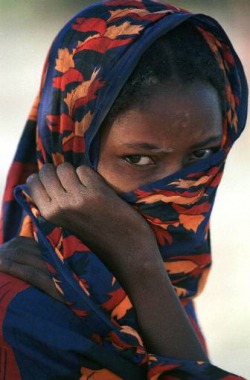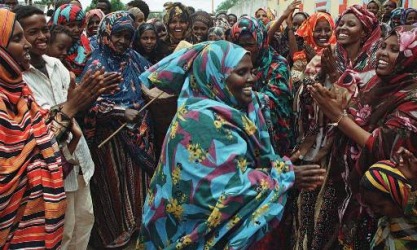Somalia: Indigenous Ethnic Groups
Class Homepage Link

The Indigenous People of Somalia
By: Bridget Giffei
In the country of Somalia people migrated from Ethiopia and Kenya, causing most of its population to be from these countries. These people spoke many dialects of Somali, but the most widely used was Common Somali (Metz). They celebrated their culture frequently and most often in rural areas (Encyclopedia Britannica Online). Wearing traditional costumes, the people of Somalia performed plays, sang, recited poetry, and danced in a folk manor. Life continued to carry on normally until the eighteenth century.
The British and Italians came to the country of Somalia to find raw materials and cheap labor. Britain took over northern Somalia, calling it Somaliland. Southern Somalia was ruled by Italy and called Somalia Italiana. In both parts of the country, slavery was occurring. The victims of raids and prisoners of war were often the sources of slaves (Cultural Orientation). They were taken to the United States, Europe, or the port cities of Merka and Brava on the coast of Somalia. There, they were forced to work on plantations. Slavery continued in southern Somalia until the twentieth century when it was abolished by the Italian authority.
With the impact of Britain and Italy, new languages began to emerge (Middleton). Now spoken were Italian and English. The cultural traditions began to decline in towns as the European influence increased (Encyclopedia Britannica Online). However, the Bantu Arabs still exist in Somalia today with a strong belief in Islam.
The Bantu Arabs aren’t the only people who had to survive the slave trade and the European influence. Today, the Somali people are deeply divided by the four levels of the clan system – the genealogical family, the clan family, the primary lineage group, and the diyapaying unit (Nnoromele). By tracing their distinct family origins, they maintain their sense of belonging and identity (Nnoromele). Children as young as six or seven years old know their family lines up to twenty generations. Clans are large and are also the cause for many wars in Somalia (Nnoromele). Today, clans still create a lot of chaos. Many people are being killed and wounded as clan insurgents fight for their clan’s power. Most clans only look out for themselves and don’t care if another clan is starving, struggling, or in danger (Jenkins). However, clans are existent to keep families together, protect one another, and to provide one’s self with identity.
Somalia: The Indigenous People
Africa: An Encyclopedia for Students. Ed. John Middleton. 4 vols. New York: Charles Scribner’s Sons, 2002. Gale Virtual Reference Library. Gale. New Trier High School Library, Winnetka, IL. 28 Apr. 2009 <http://infotrac.galegroup.com//?db=GVRL>. The Somalis are made up of people from Ethiopia and Kenya. Languages that are spoken in Somalia are Somali, Arabic, Italian, and English. Britain ruled northern Somalia and Italy ruled southern Somalia.
Jenkins, Orville Boyd. “People Profile: The Somali People of Somalia, Djibouti, and Ethiopia.” Strategy Leader Resource Kit. 5 May 2006. 28 Apr. 2009 <http://www.slrk.info//.html>. No one cares if a member of another clan starves. Somalis love poetry and have a rich oral literature.
Nnoromele, Salome C. Modern Nations of the World: Somalia. San Diego: Lucent Books, 2000. Somalis look to their clan membership for identity. Somalia is deeply divided by clan. Children as young as 6 or 7 years old can recite their genealogical lines. Most internal wars in Somalia are fought among different clans. There are many people in a clan.
Page, Willie F., Ph. D. Encyclopedia of African History and Culture. Vol. 2. New York: Facts on File Inc., 2001. Somalia converted to Islam around the 1300’s. A Somali rer is a self - controlled group of people with a descent from a common ancestor.
“People.” World 66. 28 Apr. 2009 <http://www.world66.com///>. 85% of ethnic groups in Somalia are Somali and about 30,000 people in Somalia are Bantu Arabs.
“Somalia.” Encyclopedia Britannica Online. 3 May 2009 <http://www.britannica.com//////life>. Cultural activities that take place in Somalia are poetry, folk dancing, the performance of plays, and singing. During these events, a traditional costume is usually worn. In towns, the traditional culture is slowly going away.
Somalia: A Country Study. Ed. Helen Chapin Metz. 4th ed. N.p.: n.p., 1993. The most widely used Somali dialect is Common Somali. The Somali community used teachers, preachers, and mosque officials to go along with their religion.
“Somali Bantu - Their History and Culture.” Cultural Orientation. 18 Feb. 2004. 3 May 2009 <http://www.cal.org///.html>. Many of the slaves from Somalia were being taken to the U.S. Some African slaves were transported to the port cities of Merka and Brava to work on plantations. Slavery in southern Somalia lasted until the early 20th century, when the Italian authority abolished it.
http://org.newtrier.k12.il.us/academics/faculty/hjelmgren/africa09proj3lev.html
Last Updated By Bridget Giffei on May 22, 2009

